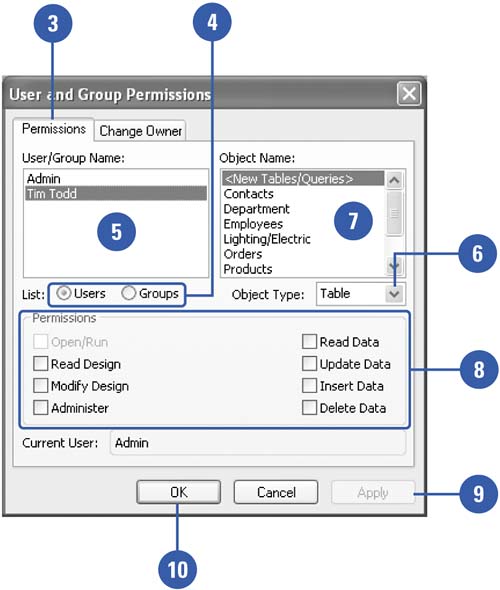Setting User and Group Permissions Once you have defined users and groups, you will want to define permissions for them. Permissions indicate the ability of each user or group to modify databases or database objects. Permissions also control a user's ability to create new objects. For example, you might want to limit the ability to view the Salaries table to a small group of users, and limit the ability to edit that table to an even smaller group. Change Account Permissions -
 | Start Access, type Admin as the user name , press Tab, and then enter the password for the Admin account. | -
 | Click the Tools menu, point to Security, and then click User And Group Permissions. | -
 | Click the Permissions tab. | -
 | Click the Users option or the Groups option, depending on whether you want to modify the rights of individual users or entire groups. | -
 | Click the name of the person or group for whom you want to change permissions. | -
 | Click the Object Type list arrow, and then select an object type. | -
 | Click the name of an existing object or click <New Object>. | -
 | Select the applicable check boxes to add or remove permissions for the selected object. | -
 | Click Apply. | -
 | Click OK. |  Select Permissions Database Permissions | Permission | Permits a User to | Applies | | Open/run | Open a database, form, or report, or run a macro | Databases, forms, and macros | | Open Exclusive | Open a database with exclusive access | Databases | | Read Design | View objects in Design view | Tables, queries, forms, macros, and modules | | Modify Design | View and change the design of objects, or delete them | Tables, queries, forms, macros, and modules | | Administer | Have full access to objects and data, including the ability to assign permissions | Tables, queries, forms, macros, and modules | | Read Data | View data | Tables and queries | | Update Data | View and modify data | Tables and queries | | Insert Data | View and insert data | Tables and queries | | Delete Data | View and delete data | Tables and queries | |
Did You Know? You can set personal identifiers for user accounts . Personal IDs contain between 4 and 20 letters (capitalization matters) or numbers or both. Along with the account name, a personal ID uniquely tags a user or group in a workgroup. Make sure you keep a copy of both the personal ID and account name in a secure location in case you need to retrieve an account that has been accidentally deleted or moved. You can simplify user permissions . Instead of assigning permissions to each user, assign permissions to groups, and then add users to the appropriate groups. You can print a list of permissions . Use the Documenter to print a report describing the permissions for each object in the database. |
|
